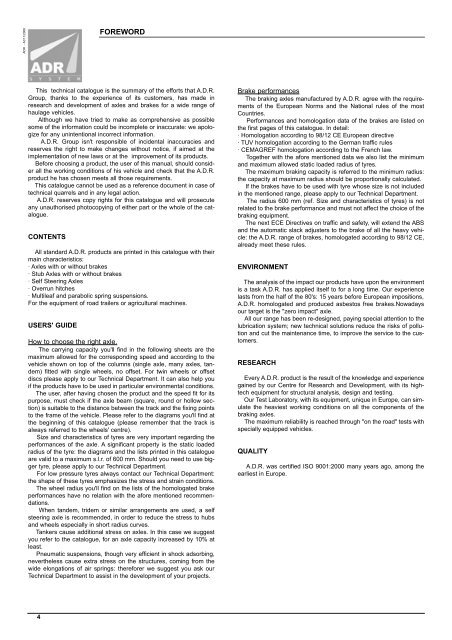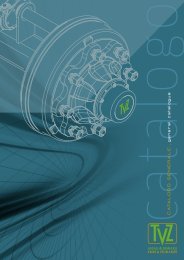Create successful ePaper yourself
Turn your PDF publications into a flip-book with our unique Google optimized e-Paper software.
ADR - AC11/2006<br />
FOREWORD<br />
This technical catalogue is the summary of the efforts that A.D.R.<br />
Group, thanks to the experience of its customers, has made in<br />
research and development of axles and brakes for a wide range of<br />
haulage vehicles.<br />
Although we have tried to make as comprehensive as possible<br />
some of the information could be incomplete or inaccurate: we apologize<br />
for any unintentional incorrect information.<br />
A.D.R. Group isn't responsible of incidental inaccuracies and<br />
reserves the right to make changes without notice, if aimed at the<br />
implementation of new laws or at the improvement of its products.<br />
Before choosing a product, the user of this manual, should consider<br />
all the working conditions of his vehicle and check that the A.D.R.<br />
product he has chosen meets all those requirements.<br />
This catalogue cannot be used as a reference document in case of<br />
technical quarrels and in any legal action.<br />
A.D.R. reserves copy rights for this catalogue and will prosecute<br />
any unauthorised photocopying of either part or the whole of the catalogue.<br />
CONTENTS<br />
All standard A.D.R. products are printed in this catalogue with their<br />
main characteristics:<br />
· Axles with or without brakes<br />
· Stub Axles with or without brakes<br />
· Self Steering Axles<br />
· Overrun hitches<br />
· Multileaf and parabolic spring suspensions.<br />
For the equipment of road trailers or agricultural machines.<br />
USERS' GUIDE<br />
How to choose the right axle.<br />
The carrying capacity you'll find in the following sheets are the<br />
maximum allowed for the corresponding speed and according to the<br />
vehicle shown on top of the columns (single axle, many axles, tandem)<br />
fitted with single wheels, no offset. For twin wheels or offset<br />
discs please apply to our Technical Department. It can also help you<br />
if the products have to be used in particular environmental conditions.<br />
The user, after having chosen the product and the speed fit for its<br />
purpose, must check if the axle beam (square, round or hollow section)<br />
is suitable to the distance between the track and the fixing points<br />
to the frame of the vehicle. Please refer to the diagrams you'll find at<br />
the beginning of this catalogue (please remember that the track is<br />
always referred to the wheels' centre).<br />
Size and characteristics of tyres are very important regarding the<br />
performances of the axle. A significant property is the static loaded<br />
radius of the tyre: the diagrams and the lists printed in this catalogue<br />
are valid to a maximum s.l.r. of 600 mm. Should you need to use bigger<br />
tyre, please apply to our Technical Department.<br />
For low pressure tyres always contact our Technical Department:<br />
the shape of these tyres emphasizes the stress and strain conditions.<br />
The wheel radius you'll find on the lists of the homologated brake<br />
performances have no relation with the afore mentioned recommendations.<br />
When tandem, tridem or similar arrangements are used, a self<br />
steering axle is recommended, in order to reduce the stress to hubs<br />
and wheels especially in short radius curves.<br />
Tankers cause additional stress on axles. In this case we suggest<br />
you refer to the catalogue, for an axle capacity increased by 10% at<br />
least.<br />
Pneumatic suspensions, though very efficient in shock adsorbing,<br />
nevertheless cause extra stress on the structures, coming from the<br />
wide elongations of air springs: thereforer we suggest you ask our<br />
Technical Department to assist in the development of your projects.<br />
Brake performances<br />
The braking axles manufactured by A.D.R. agree with the requirements<br />
of the European Norms and the National rules of the most<br />
Countries.<br />
Performances and homologation data of the brakes are listed on<br />
the first pages of this catalogue. In detail:<br />
· Homologation according to 98/12 CE European directive<br />
· TUV homologation according to the German traffic rules<br />
· CEMAGREF homologation according to the French law.<br />
Together with the afore mentioned data we also list the minimum<br />
and maximum allowed static loaded radius of tyres.<br />
The maximum braking capacity is referred to the minimum radius:<br />
the capacity at maximum radius should be proportionally calculated.<br />
If the brakes have to be used with tyre whose size is not included<br />
in the mentioned range, please apply to our Technical Department.<br />
The radius 600 mm (ref. Size and characteristics of tyres) is not<br />
related to the brake performance and must not affect the choice of the<br />
braking equipment.<br />
The next ECE Directives on traffic and safety, will extend the ABS<br />
and the automatic slack adjusters to the brake of all the heavy vehicle:<br />
the A.D.R. range of brakes, homologated according to 98/12 CE,<br />
already meet these rules.<br />
ENVIRONMENT<br />
The analysis of the impact our products have upon the environment<br />
is a task A.D.R. has applied itself to for a long time. Our experience<br />
lasts from the half of the 80's: 15 years before European impositions,<br />
A.D.R. homologated and produced asbestos free brakes.Nowadays<br />
our target is the "zero impact" axle.<br />
All our range has been re-designed, paying special attention to the<br />
lubrication system; new technical solutions reduce the risks of pollution<br />
and cut the maintenance time, to improve the service to the customers.<br />
RESEARCH<br />
Every A.D.R. product is the result of the knowledge and experience<br />
gained by our Centre for Research and Development, with its hightech<br />
equipment for structural analysis, design and testing.<br />
Our Test Laboratory, with its equipment, unique in Europe, can simulate<br />
the heaviest working conditions on all the components of the<br />
braking axles.<br />
The maximum reliability is reached through "on the road" tests with<br />
specially equipped vehicles.<br />
QUALITY<br />
A.D.R. was certified ISO 9001:2000 many years ago, among the<br />
earliest in Europe.<br />
4



